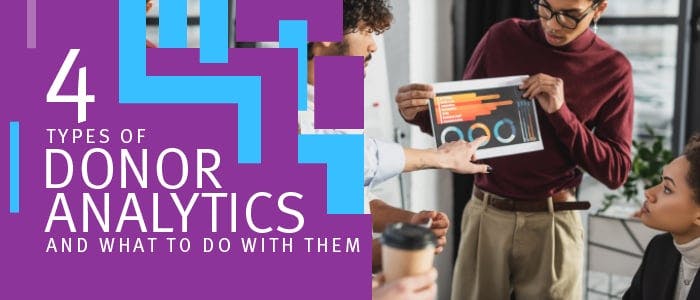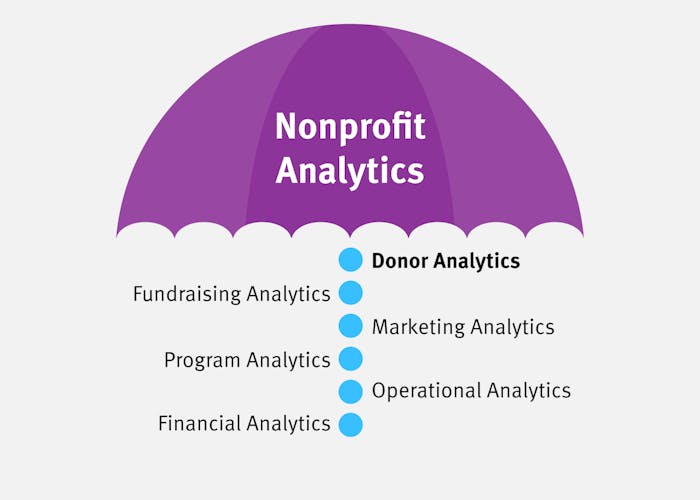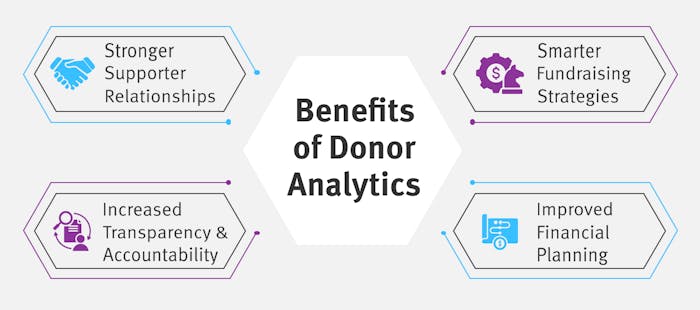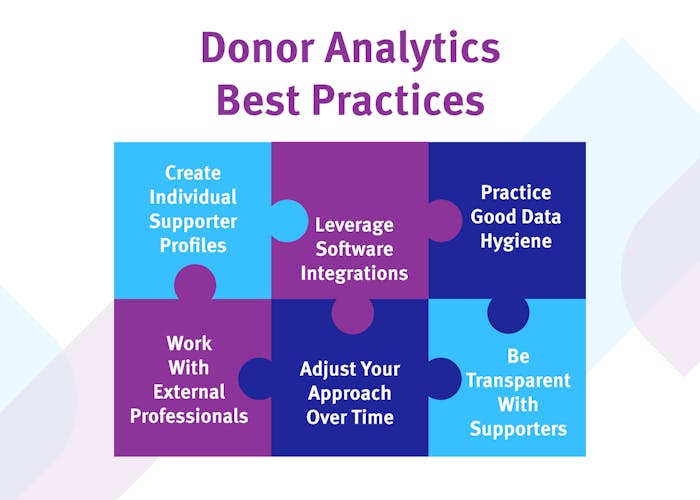
Donor Analytics: What They Are & How to Apply Them
Tuesday, September 16, 2025 by David Cassel
Your nonprofit collects a lot of data on its supporters. Every time someone makes a gift, fills out a form, or interacts with your communications, new data is created—not to mention all of the general information in your database on donors’ backgrounds and preferences. That data holds untapped potential to influence engagement, strategic planning, and financial management until you interpret and apply it through the process of analytics.
In this guide, you’ll learn all you need to know about donor analytics, including:
- What is donor analytics?
- Benefits of Donor Analytics for Nonprofits
- Types of Nonprofit Donor Analytics & Their Applications
- Donor Analytics Best Practices
Let’s get started by defining what donor analytics is and why it matters for your organization.

Develop an analytics-backed financial management strategy with expert help from Jitasa.
Request a QuoteWhat is donor analytics?
Donor analytics is the process of collecting, organizing, analyzing, and applying data on your nonprofit’s supporters. Its goal is to gather actionable insights from your stored data so you can make more informed decisions about any area of your organization’s work that directly (e.g., fundraising) or indirectly (e.g., long-term goal-setting) involves its donors.
Donor analytics and donor data aren’t synonymous—donor data is the information that feeds donor analytics, while “analytics” either refers to the process of drawing conclusions from data or the conclusions themselves. Donor analytics also falls under the larger umbrella of nonprofit analytics, which also covers conclusions drawn from fundraising, marketing, program, operational, and financial data.

Benefits of Donor Analytics for Nonprofits
Analyzing and applying donor data offers many advantages to your nonprofit, including:

- Stronger supporter relationships, which lead to increased engagement and retention.
- Smarter fundraising strategies that align with donors’ preferences and bring in more revenue.
- Improved financial planning via more efficient resource allocation, cash flow tracking, and budgeting.
- Increased transparency and accountability when you can show that your strategies are evidence-based.
These are just a few of the many benefits your organization can experience based on your exact approach to donor analytics. Plus, positive results in general hinge on analyzing the right data, applying it effectively, and taking necessary precautions to maintain donors’ trust throughout the process.

Use our Donor Privacy Policy Template to promote ethical, secure management of supporter data.
Download for FreeTypes of Nonprofit Donor Analytics & Their Applications
Now that you know the what and why of donor analytics, let’s dive into the how—the categories of donor data you should analyze and the conclusions you can pull from each one to improve your nonprofit’s operations across various areas.

Demographic Analytics
When your nonprofit is trying to acquire new supporters, it’s helpful to understand the demographics of your current supporter base. You’ll typically have an easier time reaching individuals who share similar qualities with existing donors than someone entirely different. So, targeting your outreach using demographic analytics can help lower acquisition costs and improve your return on investment (ROI).
Demographic analytics are generally based on the following donor data points:
- Age
- Gender
- Location
- Marital status
- Family status
- Education
- Employment
- Wealth
In addition to streamlining acquisition, understanding demographic analytics helps you engage existing supporters more effectively. For instance, employment data can tell you which of your supporters are eligible for workplace giving programs like matching gifts or volunteer grants that let them increase their support without contributing more out of pocket. Or, location information may help you decide whether an in-person or virtual fundraising event would attract more participants.
Be careful not to let preconceived notions or stereotypes about certain groups affect demographic analytics, especially concerning data points like age and gender. Instead, compare your interpretations of internal information t
Psychographic Analytics
Demographics only tell part of the story about your donors’ backgrounds, preferences, and opportunities. Psychological factors, also known as psychographics, supplement your knowledge of who your supporters are by telling you why they do what they do inside and outside your nonprofit.
In psychographic analytics, you should review data points like:
- Interests
- Values
- Hobbies
- Lifestyles
- Opinions
- Pain points
- Communication preferences
- Motivations for supporting your mission
When segmenting supporters (i.e., grouping them based on shared characteristics), consider psychographics alongside demographics to further target your engagement strategies. For example, universities often base donor segments on giving motivations related to relationships to the institution (alumni, parents, faculty, etc.). Segmenting by interests also works well in some cases—for instance, an animal shelter could group supporters based on whether they prefer dogs or cats and send each segment different messages about sponsoring those pets.
Psychographic analytics can even help you reach critical supporters on an individual basis. Let’s say your nonprofit tends to invite all of its major donors to its annual gala, but one longtime donor has always turned down the invitation because they “just don’t like fancy dinners.” When you review your data on that donor, you remember that they enjoy running and live a very active lifestyle. So, you decide to start sending them personalized invitations to your 5K fundraisers instead, which proves more effective for keeping them engaged between larger donations.
Giving Analytics
Understanding donor analytics related to giving patterns allows your nonprofit to gain insight into your supporters’ donation habits. If demographics and psychographics tell you the who and why of your donor base, giving analytics start to get into the what and how of their involvement with your organization.
Some essential giving data to track per supporter for analytics purposes include:
- Average donation amount
- Frequency of giving
- Recency of giving (i.e., when their last donation occurred)
- Preferred contribution channel (your website, social media, mailed-in checks, etc.)
- Lifetime value
On an individual-donor level, giving analytics can help you develop more successful donation requests. Let’s say your nonprofit has just launched a monthly giving program, and you’re conducting targeted outreach to attract your first members. You identify a donor who has given $200 to each of your last three year-end fundraising campaigns, and you ask them to join your program at $20 per month. They’d likely respond well to that request since it’s just $40 more per year than they’ve donated previously, plus they can give more conveniently as a monthly donor.
Giving analytics can also inform your nonprofit’s revenue management when considered holistically. You’ll understand fundraising data patterns and fluctuations more comprehensively, so you can adjust your plans and budget accordingly to continue funding your work. For example, you might organize a summer fundraising event to combat the dip in donations that often occurs at that time of year or add to your reserve funds leading up to elections if you notice that key supporters prioritize political giving over charitable donations at those times.
Engagement Analytics
Monetary donations aren’t the only valuable way supporters can contribute to your nonprofit. Collecting and analyzing data on other forms of involvement allows you to draw more comprehensive conclusions about your organization’s effectiveness in engaging its donors.
For this category of donor analytics, you might track:
- Interactions with communication materials (visiting your website, reading emails and texts, liking and sharing social media posts, etc.)
- Event attendance
- Volunteer time
- Advocacy campaign participation
- In-kind donations of goods, services, and non-cash assets like stocks or real estate
Analyzing non-donation involvement can help you proactively prevent donors from lapsing. For instance, in a 2024 survey of nonprofit supporters, donating items came out on top in respondents’ ranking of the most impactful ways of supporting nonprofits. So, if donors are struggling to understand their donations’ impact, you might promote in-kind giving to help them see the results of their efforts more clearly.
In-kind donations, volunteering, and advocacy are also great ways for supporters who are facing financial setbacks that temporarily make monetary giving difficult to stay involved with your organization. By keeping these donors engaged in free or low-cost activities, you’ll have an easier time retaining their support once they’re in a position to give again.
When supporters are engaged in more than one way with your nonprofit, they’re not only more likely to stay involved long-term, but they also provide value beyond their monetary donations. Engagement analytics show what they like and dislike about the various ways they can engage with your mission, so you can capitalize on what’s working well and improve or scrap initiatives that aren’t as well received.
Predictive Analytics
While there is no way to say for certain how your supporters will interact with your organization in the future, you can save essential information in your donor database that can help you get a general idea of potential involvement with your cause. These predictive analytics are based on a combination of internal and external data, and you’ll usually gather the latter through prospect research as you’re looking for new major donors.
To leverage predictive analytics, look for two major types of data:
- Wealth data, which shows how much donors could potentially give to your nonprofit and includes information about stock holdings, real estate, political giving, and other income- and asset-related details.
- Philanthropic data, which indicates whether a prospective donor would want to make a large contribution to your particular mission. Consider giving and engagement history with your organization and with other similar nonprofits in this category, as well as relevant psychographic information (interests, values, motivations, etc.).
As artificial intelligence (AI) has penetrated the nonprofit sector, predictive analytics has become an area of interest for leveraging AI-powered tools, although its potential is mostly untapped since only about 13% of nonprofits use AI for this purpose as of 2025. Whether you invest in a separate AI solution or just use the reporting tools in your donor and prospect research databases for predictive analytics, always keep data privacy and ethics at the forefront.
Donor Analytics Best Practices
Once you’ve decided what types of data to focus on and how you want to apply them, follow these best practices to make the most of your analytics approach:

- Create individual supporter profiles in your donor database or constituent relationship management (CRM) system so you have a centralized location to store their data.
- Leverage software integrations to allow data to transfer seamlessly between your CRM, fundraising, prospect research, marketing, and accounting solutions.
- Practice good data hygiene by regularly auditing your database, removing inaccurate or duplicated information, and developing data entry standards.
- Be transparent with supporters about how you’re using their information and keeping it safe, and allow them to opt out of data collection if they’d like.
- Adjust your approach over time and as your nonprofit’s goals change, so you’re always analyzing the data that’s most helpful to you in the present moment.
- Work with external professionals who can provide an objective perspective on your donor analytics and apply them in specific ways that align with their areas of expertise.
If you’re looking for help applying donor analytics to financial management, look no further than Jitasa! Our experienced team works exclusively with nonprofits, so we understand how important supporter data insights are to your organization’s financial planning, recordkeeping, and reporting. In particular, our fractional CFO and controller services are designed around strategic decision-making and involve applying donor analytics to strengthen every aspect of your nonprofit’s financial situation.
Whether you want to attract new supporters to your cause or make your fundraising efforts more efficient, donor analytics is essential to achieving your nonprofit’s goals. Use the tips and guidance above to get started, and don’t hesitate to reach out to experts for additional support in specific areas of application (like Jitasa for financial management!).
For more information on the intersection of donor data and finance, check out these resources:
- Nonprofit Financial Statements: 4 Essential Reports to Know. Explore a few key sources of financial analytics that you can use alongside donor analytics to make informed decisions.
- GivingTuesday Best Practices to Align Fundraising & Finances. Learn how to create a data-driven, financially savvy strategy for one of the biggest nonprofit fundraising days of the year.
- Restricted Funds: Everything Your Nonprofit Needs to Know. Discover the ins and outs of donor-imposed designations on gifts, which affect how you spend funding as well as your understanding of your supporters.

Partner with Jitasa to seamlessly integrate donor analytics into financial management.
Request a Quote